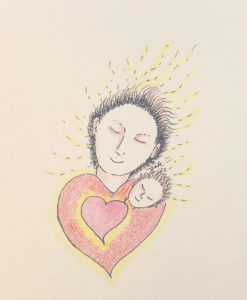
-Artwork © 2023 Jan Ketchel
Don Juan Matus explained to Carlos Castaneda that, yes, our world is a world of separate objects. However, beneath that world of separateness, we are all in a state of one interconnected energy. In that state of oneness, love is the energy of cohesion, that which holds together and welcomes all of its neighbors.
Don Juan also explained that we live in a predatory universe. Indeed, all life feeds upon life, and yet, at a soul level, energetic life is never lost, it merely changes form.
Survival, in our separate human form state, requires an instant ability to judge safety and danger. That which we judge to be dangerous we come to hate. Hate is the emotion that allows us to dehumanize and destroy that which we judge to be different and threatening to our survival.
Oneness and separateness are a pair of opposites that constitute a core challenge to life in human form. It all begins with the symbiotic oneness of mother and embryonic fetus, in pregnancy, that ends in the separation of the one into two distinct beings at birth. The challenge to become a fully realized separate being, who can open to the oneness of love, is the art of human life.
We are drawn to relationship in a quest to reunite with our lost oneness. Union is driven by the natural attraction of opposites for each other. This is love in energetic motion. When these opposites unite there is frequently a honeymoon phase, where opposites relish the relief and ecstasy of restored oneness.
However, as relationships progress, one’s separate, differentiated self reemerges and finds itself in opposition with its soulmate. This reemergence frequently leads to competition and opposition of viewpoints in the relationship. The couple is then challenged to make room for their differences in the wholeness of their relationship. Far too often, bearing the tension of these unreconciled opposites results in the solution to hate one’s partner and end the relationship.
The solution of hate, devaluation, and demonization of the other is the frequent outcome of attempting to bear the extraordinary tension of differences necessary to reach a reconciling of opposites. This is evident in the wars that plague our world. The underlying energetic imperative to embrace all parts and peoples of the world in the oneness that we truly are is the evolutionary and karmic challenge of our time.
Beneath the opposites of love and hate is the oneness and separation phases of human and cosmic evolution. The separatist, hateful stage of human interaction must ultimately acquiesce to the greater harmony and love of energetic reality, which, like day turning into night, will naturally reassert itself.
As we live through this stage of human evolution, which emphasizes separateness and hate in human relations, may we bear its tension and find the path that will lead us to our underlying wholeness, with renewed balance. This is the path where love and hate meet in a union that makes room for all.
Bearing the tension of love and hate,
Chuck




